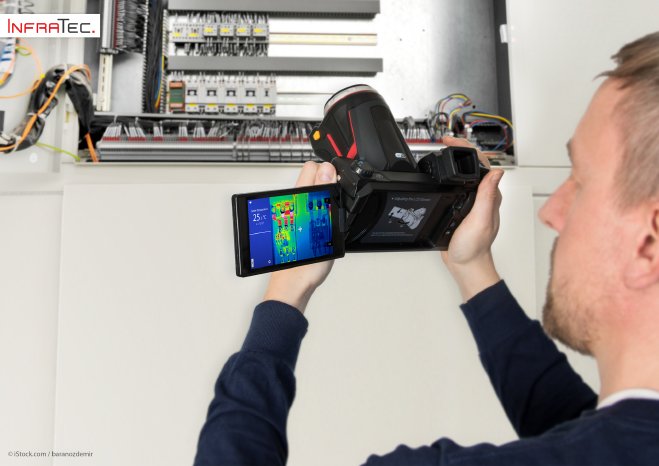Right from the very first image it becomes apparent where the strength of this uncooled microbolometer camera for building thermography and predictive maintenance lies. Its detector with the (400 × 300) IR pixels format is paving the way for thermal images, whose sharpness and richness of detail have been unrivalled in this device class so far. A total of 120,000 IR pixels allow temperature distributions on the surface of measurement and test objects to be accurately recorded and displayed. This number of pixels exceeds the value, which cameras with the standard format of (320 × 240) IR pixels reach, by more than 50 percent.
Technical peak values as a basis of real benefits
This means a benefit for compactIR 400 users in numerous situations. Larger areas can be captured per image, which saves valuable time, such as during the inspection of large-scale industrial plants. Consequently, the work involved when making the measurements decreases due to the larger detector format. Under other conditions the measurement results become significantly more accurate. If the image detail to be examined is identical, the temperature recording of the compactIR 400 is based on considerably more measuring points compared with a camera with a smaller detector format. Thus, the images are more detailed.
Apart from the geometrical resolution, the thermal resolution is also at the highest level for a camera of this performance class. Hence, temperature differences of up to 45 mK can be detected reliably. This guarantees the necessary certainty and precision for a wide variety of measurements. The temperature measuring range already reaches 800 °C by default and can optionally be extended up to 2,000 °C. Thus, for users of these devices numerous potential applications are coming to the fore.
Ready for every situation thanks to extensive features
The camera is just as versatile when considering the available lenses. In addition to the standard lens, other options are available to users with a telephoto and wide-angle lens. Regardless of whether or not details of the measuring object are far away or extremely close, the appropriate interchangeable lenses ensure first class image quality at all times. The motorized focus with automatic function also supports the focusing accuracy. Thus, users keep the targeted subject constantly in view and benefit from high-resolution images in the end.
This applies above all to situations that pose particular challenges, such as overhead thermal images or objects that are difficult to access. In such moments the compactIR 400 demonstrates its versatility. To simplify work considerably if inconvenient angles make the perfect shot of a motive almost hopeless, the lens units can be tilted up to 70°. Whether the image was successful, this is indicated by the 5" TFT colour display with (1,280 × 720) pixels. The value in this device class is also unrivalled and allows an accurate evaluation of the thermal images immediately after recording on site.
The display also serves as a touchscreen and can be rotated up to 270° and swivelled 180°. Rubberised grip plates, large buttons as well as the weight of just 1,150 g including standard lens are further refinements that guarantee extremely comfortable handling of the camera. It is easy to operate at any time – optionally with one hand or both hands.
Clearly evaluating data for a wide variety of measuring tasks
The analysis and evaluation of measurement results can be carried out just as conveniently. Users, for example, can generate reports in PDF format already on the camera, transfer them to a printer via a Wi-Fi interface and print them immediately. The thermographic IRBIS® 3 software family developed by InfraTec is suitable for more detailed inspections. With software packages such as IRBIS® 3 report it offers solutions that have been designed specifically for architects, consultants and engineers and have been appreciated by such users for many years.
In light of these features, the compactIR 400 is opening up an extremely wide range of applications. This includes the entire range of inspections that are necessary for the maintenance of mechanical and electrical installations. The same applies to building thermography and building diagnostics. With the aid of this camera, for example, users can assess the quality of construction projects in the course of renovation, prepare forecasts for the hazards posed by mildew or receive support when calculating the costs for energy consumption.


